Pekka Buttler 01/2024
This article tries to put together a list of Soviet interchangeable lenses for 35 mm and medium format1. When possible, links to articles/reviews on the lenses are given (both on JAPB and elsewhere).
Before we go on, I’m going to quote from the JAPB article on the soviet lens ‘business’:
“Dear reader, if you’re from a western market economy, you probably think of companies and brands as ceaselessly competing entities. Nikon does what Nikon does because they’re reacting to what Canon did and so on…
Most westerners are so inundated by this thinking that we might instinctively view Soviet lenses the same way: as a competition between the Jupiters, the Helioses, the Mirs and so on. Allow me to exemplify why that approach is unfruitful.
The Helios-44 is very likely the most mass-manufactured interchangeable lens in photographic history to date. It is also quite famous. Not only is the Helios-44 the descendant of the Carl Zeiss Jena Biotar 58 mm f/2, but it is also well loved, especially for its tendency to produce swirly bokeh. But Helios is neither a company nor a brand. Instead ‘Helios’ is the designation of a collection of designs. The ‘original’ duo (Helios-40 and Helios-44) of Helios lenses were remakes of the Carl Zeiss Jena Biotar and subsequent Helios lenses (Japanese Helios’ exempted) were typically further developments of these and similar designs.”
In 90% of cases, the name of a Soviet lens is either:
a) a reference to a family of designs (tessars, sonnars, retrofocals…)
b) a reference to a specific type of use (repro lenses, projection lenses aerial lenses).
Below, I’m going to try to go into all of these (as much as possible). I have omitted most of those known designs that never made it into serial production, but as both my sources (and google translate) might not have the whole truth, these should be taken with a grain of salt.
Related articles:
• The Soviet lens ‘business’
• A Soviet Nikon?
• Soviet Serial numbers.
Table of Contents
- Granit (Гранит)
- Helios (Гелиос)
- Industar (Индустар)
- Jupiter (Юпитер)
- Kaleinar (Калейнар)
- Mir (Мир)
- MTO (МТО)
- Oberon (Оберон)
- Orion (Орион)
- Rubin (Рубин)
- Russar (Руссар)
- Sputnik (Спутник)
- Tair (Таир)
- Telear (Телеар)
- Telemar (Телемар)
- Triplet (Триплет)
- Vega (Вега)
- Volna (Волна)
- Yantar (Янтарь)
- Yashma (Яшма)
- Zenitar (Зенитар)
- ZM (ЗМ)
- Zodiac (Зодиак)
- Honourable mentions:
- Epilogue: Post-Soviet lenses
Granit (Гранит)
Family of Tele zooms manufactured by the Arsenal plant in Kiev and (post-Soviet) later offered under the ARSAT name.
Granit (granite) is one the series of names of lenses that are referencing minerals and gemstones.
| Designation | Focal length | Max. Aperture | Notes | Links |
| Granit-11A/11M/11 AUTOMAT | 80-200 mm | f/4.5 | Non-multicoated tele zoom from late 70s-90s A (Arsenal) and M (KMZ) versions for M42 mount, AUTOMAT version for Kiev Automat mount. | [page] |
| MC Granit-11N | 80–200 mm | f/4.5 | Multicoated tele zoom, introduced 1983 for Kiev 17/19 series of cameras. Adapter to M42 included in delivery. Nikon F mount. Lens continued to be made & sold in post-Soviet era as “Arsat H 80-200/4.5” | [page] |
Helios (Гелиос)
The origins of the early (post-WWII) Helios-40 and 44 lenses is that they are both remakes of CZJ Biotars, of the 58/2 and the 75/1.5. Thereafter the name was used for a wise array of double-Gauss type bright standard lenses.
The Etymology of the name seems extraordinarily muddled. There is a clear link to to the god of the sun (from greek mythology), which would make a special kind of sense if the Helios series would be the Soviet remakes of the Zeiss Sonnars (Sonnar->Sonne (german for Sun)), but as the original Helios’ were Biotar remakes …
(What further muddles the waters is that in the 70s and 80s lenses were produced in Japan that also use the Helios name)
| Designation | Focal length | Max. Aperture | Notes | Links |
| Helios-40 | 85 mm | f/1.5 | Soviet Remake of the CZJ 75&/1.5 Biotar (without fancy glasses resulting in a 85/1.5). Available for Z39 and M42 mounts. | [page] |
| Helios-44 | 58 mm | f/2 | Remake of the CZJ Biotar. One of the most mass-produced lenses. Available in Z39, M42, Pentax K and Start bayonet2 mounts. | [page] [JAPB] |
| Helios-65 | 50 mm | f/2 | Double-Gauss Standard lens. Available for Kiev Automat, rarely LTM or Soviet-DKL mounts. | [video] |
| Helios-77 | 50 mm | f/1.8 | Late Soviet-era standard lens. Available for M42 and Pentax K mounts. | [page] |
| Helios-81 | 50 mm (53 mm) | f/2 | Standard lens for Kiev 17/19 cameras. Available mainly for Nikon F, also rarely in M42 and Kiev Automat mounts. | [page] [JAPB] |
| Helios-94 | 50 mm | f/1.8 | Standard lens for short-lived Kiev-5 rangefinder. Available only for Kiev-5 (modified Contax/Kiev mount) | [video] |
| Helios-103 | 53 mm | f/1.8 | Early 80s standard lens for late Kiev 4 rangefinders. Available for Contax/Kiev mount. | [JAPB] |
| Helios-123 | 50 mm | f/1.4 | Intended as fast fifty for Kiev 17/19 cameras. One trial batch produced. Available for Nikon F mount. (Produced in the post-Soviet era as the Arsat H 50/1.4) | [page] |
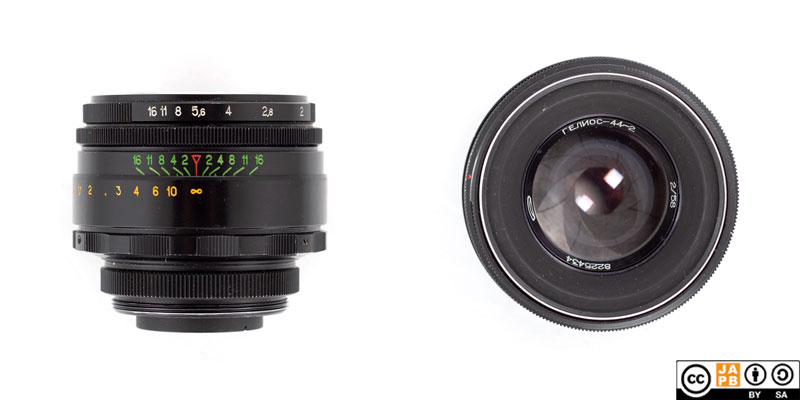
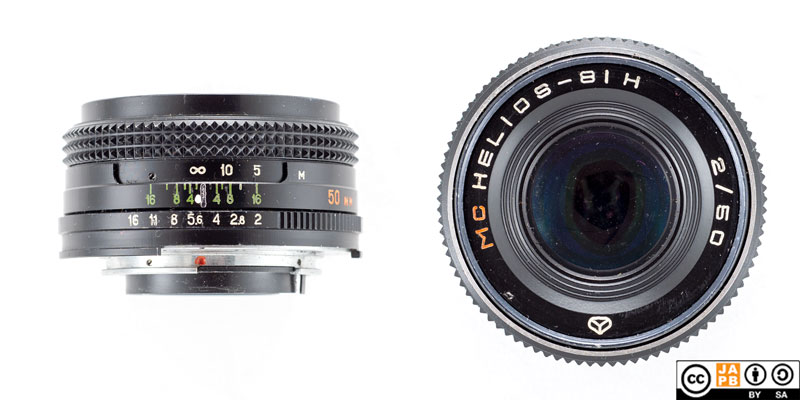
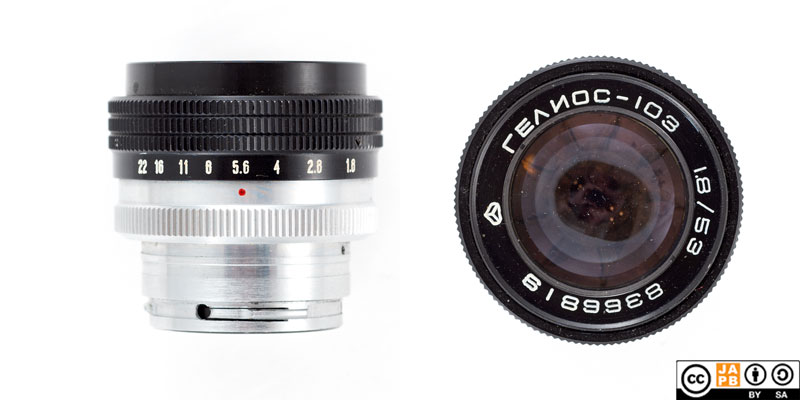
Industar (Индустар)
The name Industar combines a reference to industry and industrialisation with an -ar ending typical for lenses. Most Industar lenses for cameras were derivatives of the Tessar design
| Designation | Focal length | Max. Aperture | Notes | Links |
| Industar-22 | 50 mm | f/3.5 | Remake of the retractable Leica Elmar of similar specs. Later also an early SLR lens. Available for LTM and Z39 mounts. | [page] |
| Industar-24 | 105 mm | f/3.5 | Lens used in both Moskva-5 medium format folding cameras and as a preset aperture interchangeable lens for early Zenit (Z39) cameras. | [page] |
| Industar-26 | 50 mm | f/2.8 | Standard lens for FED rangefinders and later early Zenit SLRs. Available for LTM and Z39 mounts. | [page] |
| Industar-29 | 80 mm | f/2.8 | Standard Lens for Salyut. 1957-1973. Kiev-88 mount. | |
| Industar-50 | 50 mm | f/3.5 | Replacement for Industar-22. Tessar-type for rangefinders (retractable or rigid) and SLRs. Available for LTM, Z39 and M42 | [JAPB] |
| Industar-61 | 50 mm | f/2.8 | Tessar-type for rangefinders and SLRs. Many different versions since early 70s. Available for LTM, M42 and Zenit-73. Was also used as fixed lens. | [page] [JAPB] |
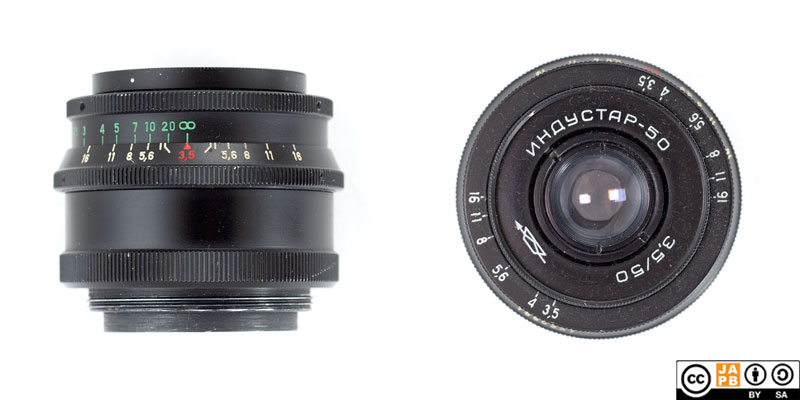
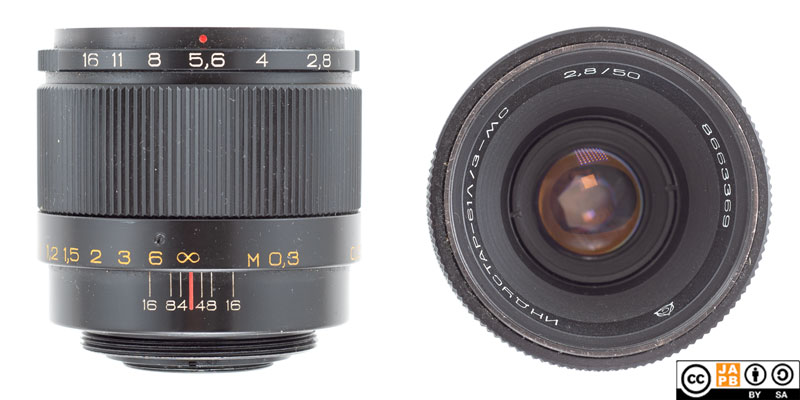
Jupiter (Юпитер)
The Original Jupiter lenses (3, 6, 8, 9, 11 and 12) were all remakes of existing Carl Zeiss Jena Sonnar designs for rangefinders and SLRs. In later years the Jupiter name was used both for Sonnar-type tele lenses and rangefinder standard lenses.
The origins of the naming is unclear, but the Soviet Union loved references to space (there are lenses named Jupiter, Titan, Saturn, Orion, Neptun, Mars etc.)
| Designation | Focal length | Max. Apert. | Notes | Links |
| Jupiter-3 | 50 mm | f/1.5 | Soviet remake of Zeiss’ 50/1.5 Sonnar. In production 1948–1980s. Available for LTM and Contax/Kiev mounts. | [page] |
| Jupiter-6 | 180 mm | f/2.8 | Soviet remake of Zeiss’ “Olympia Sonnar” Introduced mid 50s. Available for Z39 (Jupiter 6) and M42 (Jupiter 6-2) | [page] |
| Jupiter-8 | 50 mm | f/2 | Soviet remake of Zeiss’ 50/2 Sonnar. In production 1948–1980s. Available for LTM and Contax/Kiev mounts. | [JAPB] [page] |
| Jupiter-9 | 85 mm | f/2 | Soviet Remake of Zeiss 85/2 Sonnar for Contax rangefinder. Numerous variants. In production for ≈50 years. Available in Contax/Kiev, Z39, M42, Kiev Automat. | [JAPB] [page] |
| Jupiter-11 | 135 mm | f/4 | Soviet Remake of Zeiss 135/4 Sonnar. Introduced late 40s. Numerous variants. Available in LTM, Contax/Kiev, Z39, M42, Kiev Automat. | [JAPB] [page] |
| Jupiter-12 | 35 mm | f/2.8 | Remake of Zeiss’ 35/2.8 Biogon. For rangefinders. Available for Contax/Kiev and LTM mounts. | [JAPB] |
| Jupiter-17 | 50 mm | f/2 | Rare, simplified version of Jupiter 8. Available in LTM and Narcissus (M24x1) mount | [page] |
| Jupiter-21 | 200 mm | f/4 | Sonnar-type telefoto lens for SLR cameras. Available in Z39 and M42 mount | [video] |
| Jupiter-25 | 85 mm | f/2.8 | Short Tele lens for Zenit 4/5/6 cameras. Rare. Available in Soviet-DKL. | [page] |
| Jupiter-36 | 250 mm | f/3.5 | Medium Tele lens for medium format SLR. Late 60s to 1991. Pentacon Six and Kiev-88 mounts. | [page] |
| Jupiter-37 | 135 mm | f/3.5 | Medium Tele lens for SLR cameras. Available in M42 and Kiev Automat. | [page] |
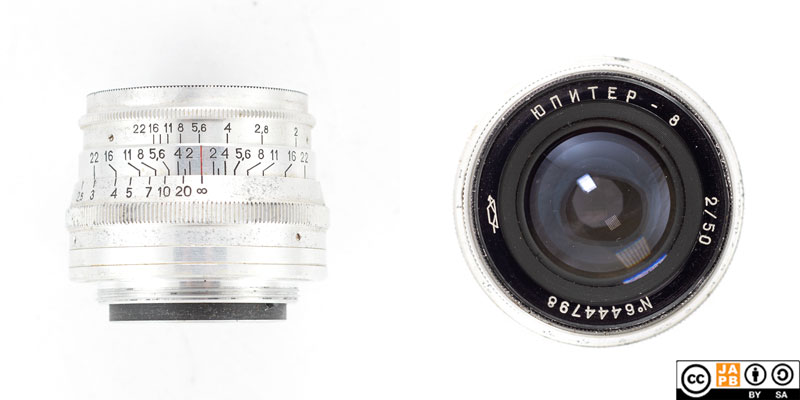

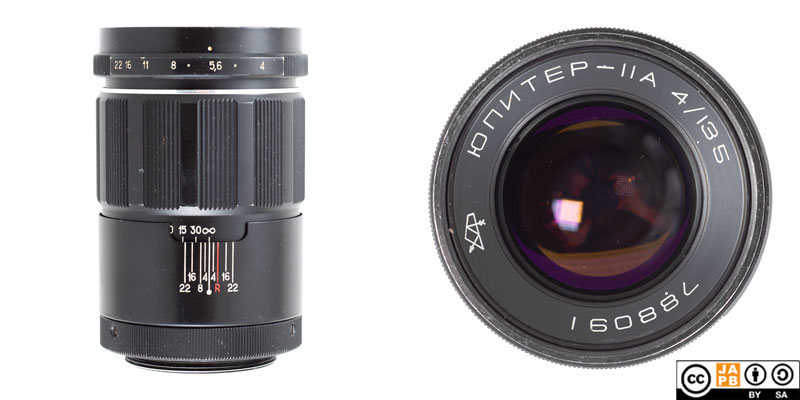

Kaleinar (Калейнар)
Family of short telephoto lenses manufactured by the Arsenal plant in Kiev. Origins of name seem to be linked to an (unrelated) lens design bought by the Soviet Union in the 1930s, but may also contain a reference to ‘Kaleidoscope’.
| Designation | Focal length | Max. Aperture | Notes | Links |
| Kaleinar-3 | 150 mm | f/2.8 | Short telephoto lens for Kiev medium format SLR cameras. Pentacon Six and Kiev-88 mounts. | [page] |
| Kaleinar-5 | 100 mm | f/2.8 | Bright Short telephoto lens (1981-92) for Kiev 17/19 cameras. Originally sold with M42 adapter. Available for Nikon F mount. | [page] |
Mir (Мир)
MIR is the family name for wide-angle lenses manufactured on the retrofocus principle, Many early designs are remakes of Carl Zeiss Jena’s Flektogons
The word Mir most commonly means both ‘peace‘ and ‘world‘, and historically it has also meant ‘community‘. Moreover, in the Soviet era the word found many uses, ranging from diplomatic slogans to names of major achievements (the space station) as well as in products and brands (watches, books, lenses, toys …)
| Designation | Focal length | Max. Aperture | Notes | Links |
| MIR-1 | 37 mm | f/2.8 | Introduced 1954, Based on original CZJ Flektogon. Available for Z39, M42 Soviet-DKL and Kiev Automat mounts. | [page] |
| MIR-3 | 65 mm | f/3.5 | Introduced 1957. Originally for Salyut MF camera, since 1971 also available for Kiev MF camera. Available for Pentacon Six and Kiev-88 mounts | [page] |
| MIR-10 | 28 mm | f/3.5 | Introduced late 60s, Available for Z39 and M42 mounts. | [page] |
| MIR-20 | 20 mm | f/3.5 | Introduced early 70s. Mulitcoated (MIR-20 MC) since mid 80s Available for M42, Nikon F and Kiev Automat mounts. | [page] [video] |
| MIR-24 | 35 mm | f/2 | Earlier (uncoated) M42 versions since late 60s, multicoated since late 70s Available for M42 and Nikon F mounts. | [JAPB] |
| MIR-26 | 45 mm | f/3.5 | Wide-angle for medium format. Introduced 1970. Available for Kiev-88 (since 1970) and Pentacon Six mounts (since 1974). | [JAPB] [page] |
| MIR-38 | 65 mm | f/3.5 | Replacement for MIR-3. Introduced 1978. Available for Pentacon Six and Kiev-88 mounts. | [JAPB] [page] |
| MIR-47 | 20 mm | f/2.5 | Only occasional production series. Introduced 1979, Available in M42 and Pentax K mounts. | [page] |
| Mir-67 | 35 mm | f/2.8 | Shift-lens for Kiev 17/19 series. Nikon F mount. Continued as PCS Arsat H 35 mm f/2.8 | [page] |
| MIR-73 | 20 | f/2.8 | Introduced as a Soviet design, but reached serial production (as the Arsat H 20/2.8) only in post-soviet era. Nikon F mount. | |

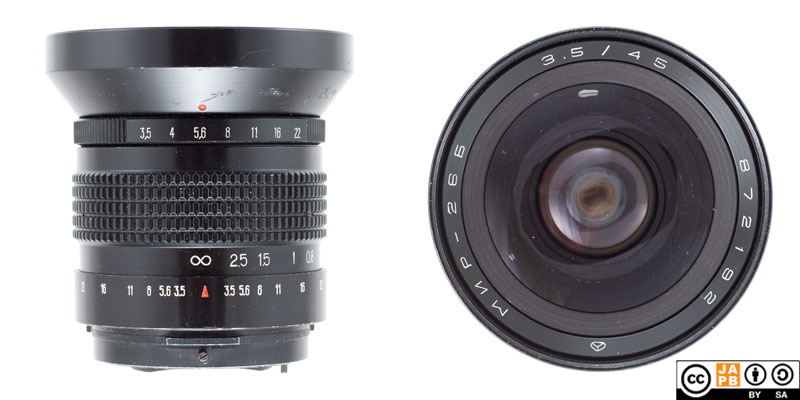
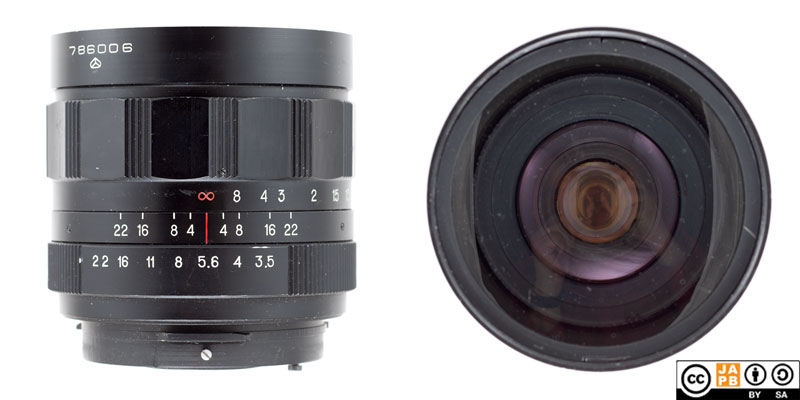
MTO (МТО)
MTO is an abbreviation that can either mean “Maksutov tele lens (Объектив)” or “Meniskus tele lens” – a category of catadioptric (mirror) tele lenses with focal lengths in the range of 350 mm to 1000 mm, manufactured starting 1953.
| Designation | Focal length | Max. Aperture | Notes | Links |
| MTO | 350 mm (35 cm) | f/5.6 | Introduced 1953. M42 mount. | [Page] |
| MTO-500 | 500 mm (50 cm) | f/8 | Introduced 1953. M42 mount. | [Page] |
| MTO-500A | 550 mm | f/8.5 | M42 mount. | [Page] |
| MTO-1000 | 1000 mm | f/10 | Introduced 1955. M42 mount. | [Page] |
| MTO-1000A | 1100 mm | f/10.5 | M42 mount. | [Page] |
| MTO-11 | 1000 mm | f/10 | Introduced 1982, M42 mount. weight 2,3 kg | [Page] |
| MTO-11SA | 1000 mm | f/10 | Light-version of MTO-11, M42 mount. weight 1,95 kg |
Oberon (Оберон)
The Oberon name seems a one-of-a-kind. Maybe someone was planning on this lens to be the first of many oberon? Again, there is a possible link to Oberon a moon of the planet Uranus…
| Designation | Focal length | Max. Aperture | Notes | Links |
| Oberon-11 | 200 mm | f/2.8 | Large-aperture tele lens introduced 1990. Available for Pentax K mount. | [video] |
Orion (Орион)
The name Orion contains a reference to space. Fittingly most Soviet lenses manufactured to carry the Orion name were intended for astro and aerial photography.
| Designation | Focal length | Max. Aperture | Notes | Links |
| Orion-15 | 28 mm | f/6 | Remake of Zeiss Topogon. Symmetrical wide-angle for rangefinders. Available in LTM and Contax/Kiev mount. | [page] |
Rubin (Рубин)
Rubin and Rubinar are names used by the Lytkarino plant (LZOS) for their lenses. Part of the minerals/gemstones series.
| Designation | Focal length | Max. Aperture | Notes | Links |
| Rubin-1 | 37–80 mm | f/2.8 | Soviet Union’s first Zoom. Available in Soviet-DKL. | [page] |
| MC Rubinar-1000 | 1000 mm | f/10 | Mirror lens. M42 mount. | [page] |
| MC Rubinar-500 | 500 mm | f/8 | Mirror lens. M42 mount. | [page] |
| MC Rubinar-500 | 500 mm | f/5.6 | Mirror lens. M42 mount. | [page] |
| MC Rubinar-300 | 300 mm | f/4.5 | Mirror lens. M42 mount. | [page] |
Russar (Руссар)
The name is a complex combination of the name of a designer (M. Rusinov) an -ar ending typical for optics, with a double s thrown in for the sake of patriotism. Many Aerial photography lenses were named Russar, but there is a rather legendary photographic interchangeable lens by that name also.
| Designation | Focal length | Max. Aperture | Notes | Links |
| Russar MR-2 | 20 mm | f/5.6 | Legendary symmetrical wide-angle for rangefinder cameras. Available in LTM mount. | [page] |
Sputnik (Спутник)
Sputnik is the Russian word for satellite (derived from fellow traveller). As such the name fit Soviet naming practices well even without the famous first satellite of that name.
| Designation | Focal length | Max. Aperture | Notes | Links |
| Sputnik-4 | 20 mm | f/4.5 | Nearly symmetrical wide-angle, likely modelled on Bertele’s 1951 Zeiss Biogon (21/4.5). Available for LTM mount. | |
Tair (Таир)
A family of telephoto lenses. While believable sources4 link the name to lake Tair (56.273554, 47-846542) near the town where the lens designer D.S. Volosov was located during the 1940s evacuation (and when the lenses were designed), other sources maintain there would be a link to Altair.
| Designation | Focal length | Max. Aperture | Notes | Links |
| Tair-3 | 300 mm (30 cm) | f/4.5 | High-performance long Telephoto lens, produced for ≈50 years in several variants, including a version for use with the ‘Fotosnaiper’ apparatus. Available: Z39 and M42. | [page] |
| Tair-11 | 135 mm | f/2.8 | Originally introduced 1947, this wide-aperture medium tele lens was in production for 40+ years and went through several design iterations. Available: Z39 and M42. | [page] [video] |
| Tair-33 | 300 mm | f/4.5 | Telephoto lens for medium format SLR. Mid 60s–mid 70s. Kiev-88 mount. | |
| Tair-38 | 135 mm | f/4 | Medium telephoto lens for Zenit 4/5/6 leaf shutter cameras. Rare. Available in Soviet-DKL. | [page] |
| Tair-56 | 150 mm | f/2.8 | Medium telephoto lens for SLR. Available in Z39 and M42 | [page] |
Telear (Телеар)
‘tele’ with an ‘-ar’ ending.
| Designation | Focal length | Max. Aperture | Notes | Links |
| Telear-N | 200 mm | f/3.5 | Longer brother of the Kaleinar-5. Also equipped with Nikon F–>M42 adapter. Available in Nikon F mount. (1985–≈1994) | [page] |
| Telear-5 | 250 mm | f/5.6 | Medium Telephoto lens for medium format. Pentacon Six and Kiev-88 mounts. | [page] |
Telemar (Телемар)
Telemar is a contraction of Telephoto Marinsky. Telemar lenses were more prevalent in military applications (e.g. Aerial photography), but some camera lenses were also produced under that name.
| Designation | Focal length | Max. Aperture | Notes | Links |
| Telemar-22 | 200 mm | f/5.6 | Telefoto lens for SLR cameras, Early version for Z39 mount, later ’22A’ version for either Z39 or M42. | [page] |
Triplet (Триплет)
Triplet was a name used for (surprise!) triplet lenses. No production interchangeable lenses carried the name ‘triplet’, but ‘triplet’ lenses were common in compact cameras.
Vega (Вега)
Likely another astro/space reference…
| Designation | Focal length | Max. Aperture | Notes | Mounts | Links |
| Vega-3 | 50 mm | f/2.8 | Standard lens for Zenit 4, 5 and 6 cameras. | Soviet-DKL | [page] |
| Vega-12 | 90 mm | f/2.8 | Standard lens for Salyut-S and Kiev 88 cameras. Later also for Kiev 6C and Kiev 60 | Kiev 88 Pentacon Six | [JAPB] [page] |
| Vega-13 | 100 mm | f/2.8 | Short Telephoto lens (1971-84). | M42 | [page] |
| Vega-28 | 120 mm | f/2.8 | Short tele for medium format Kiev SLRs. | Pentacon Six Kiev-88 | [page] |
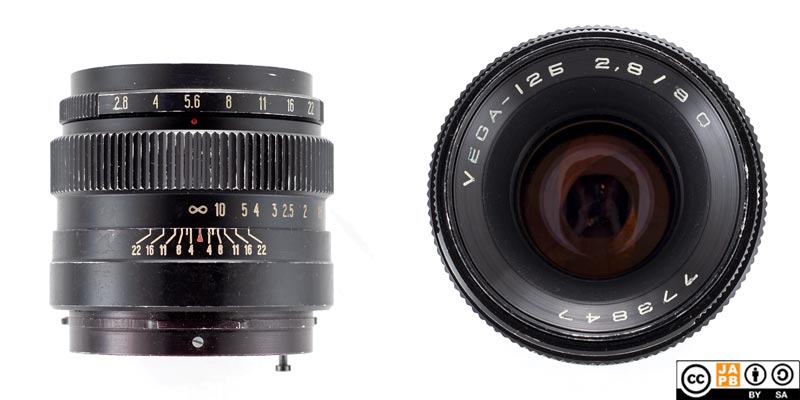
Volna (Волна)
A family of bright standard lenses. Volna is Russian for ‘wave’
| Designation | Focal length | Max. aperture | Notes | Mounts | Links |
| Volna-1 | 50 mm | f/1.8 | Standard lens for Almaz cameras. | Pentax K | [page] |
| MC Volna-3 | 80 mm | f/2.8 | Standard lens for Kiev Medium format SLR cameras. Early samples without multicoating.5 | Pentacon Six Kiev-88 | [JAPB][page] |
| Volna-4 | 50 (53) mm | f/1.4 | Experimental series for Almaz and Kiev17/19 cameras. In small series production 1978–1984. | Pentax K Nikon F | [page] |
| Volna-9 | 50 mm | f/2.8 | Macro lens with MFD 0,24 m. Introduced 1984. | M42 | [JAPB] [page] |
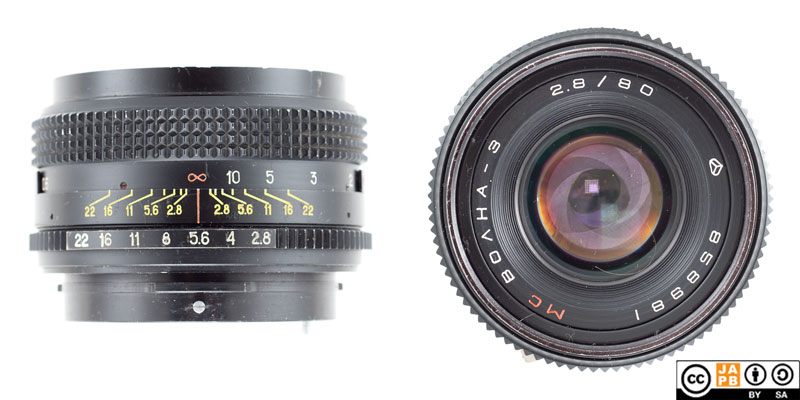
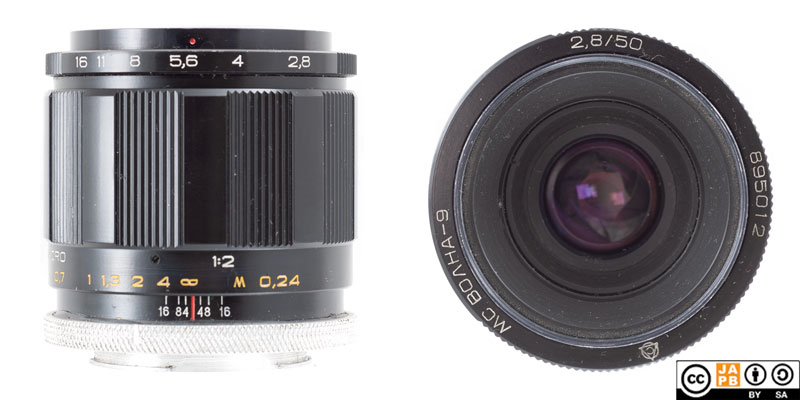
Yantar (Янтарь)
Yantar means amber. Name is likely a part of the minerals/gemstones series.
| Designation | Focal length | Max. Aperture | Notes | Links |
| Yantar-14N Macro | 28-82 mm | f/2.8–4 | Standard Zoom for Kiev 17/19 series cameras. In production 1985-90. Rare. Nikon F mount. | [page] |
Yashma (Яшма)
Yashma means Jasper. Again one in the minerals/gemstones series of names.
| Designation | Focal length | Max. Aperture | Notes | Links |
| Yashma-4 | 300 mm | f/2.8 | Large aperture Tele lens for Kiev 17/19 series of SLR. Rare. Nikon F mount | [page] |
Zenitar (Зенитар)
Zenitar and its derivatives (telezenitar, variozenitar) are names for lenses coming from the KMZ factory and were increasingly used starting in the 1970s. The Zenitar name appeared relatively late into the nomenclature of Soviet lenses and can be seen as part of a transition away from more traditional design-based naming to more organisation-based naming.
| Designation | Focal length | Max. Aperture | Notes | Links |
| MC Zenitar 16/2.8 | 16 mm | f/2.8 | Fisheye. Originally for Pentax K and M42, later M42, Canon EF and Nikon F mounts. | [manufacturer] |
| MC Zenitar-M 1,7/50 | 50 mm | f/1.7 | Standard lens, produced late 70s–80s. M42 | [page] |
| MC Zenitar-ME1 1,7/50 | 50 mm | f/1.7 | Special version developed for Zenit-18 camera with electronic aperture communication. Square aperture. M42 | [video] |
| MC Zenitar 1,9/50 | 50 mm | f/1.9 | Standard lens for entry level SLRs. Production 1991-1994. M42, Pentax K | [page] |
| MC Zenitar 2/50 | 50 mm | f/2 | Modest-aperture standard lens. Nicknamed the ‘bullet’ due to its shape. M42, Pentax K | [page] |
| MC Zenitar-1K 1.4/85 | 85 mm | f/1.4 | Small Scale production 1991-92. Not same as modern version by Zenit Foto. Pentax K | [page] |
| MC APO Telezenitar-M 2.8/135 | 135 mm | f/2.8 | Large-aperture medium telefoto. Introduced 1983, Small-batch production. M42 | [page] |
| MC Telezenitar 4.5/300 | 300 mm | f/4.5 | Long tele lens with several versions (Telezenitar=>Fotosnaiper; Telezenitar-M=>M42; Telezenitar-K=>Pentax K). 1975–1980 | [page] |
| MC APO Telezenitar 4.5/300 | 300 mm | f/4.5 | Updated version of above. Introduced 1988. M42, Pentax K | [page] |
| MC Variozenitar 2.8-3.5/25-45 | 25–45 mm | f/2.8–3.5 | Wide-angle zoom, developed in mid 80s. M42 |
ZM (ЗМ)
Abbreviation from Mirror-Meniscus.
| Designation | Focal length | Max. Aperture | Notes | Mounts | Links |
| ZM-3 | 600 mm | f/8 | Mirror lens for medium format. | Pentacon Six | [page] |
| ZM-4A | 500 mm | f/6.3 | Mirror lens. Introduced 1975. | M42 | [page] |
| MC ZM-5A | 500 mm | f/8 | Mirror lens 5A version introduced 1973; 5SA (weight-reduced) version introduced 1983. | M42 | [page] |
| (MC) ZM-6A | 500 mm | f/6.3 | Mirror lens. Non-MC version introduced 1979; MC version introduced 1985. | M42 | [page] |
| MC ZM-7 | 300 mm | f/5.6 | Mirror lens with semi-decent close-up capability. | Pentax K | [page] |
Zodiac (Зодиак)
Another heavenly reference. Fisheye lenses.
| Designation | Focal length | Max. Aperture | Notes | Mounts | Links |
| Zodiak-2M2 | 15 mm | f/3.5 | Fisheye. | M42 | [page] |
| Zodiak-8 | 30 mm | f/3.5 | Fisheye for Medium Format. 6 | Pentacon Six Kiev-88 | [page] |
Honourable mentions:
In case you had not had enough yet, there are a number of lenses that – while never getting past the prototype stage – are sufficiently interesting to mention:
• ERA-18 (50 mm f/1.2 lens for Kiev 10/15/17/19 SLRs)
• Fodis-1K (135 mm f/1.8 lens for Pentax K mount)
• MIR-46 (35 mm f/1.4 lens from early 80s)
• MIR-51 (15 mm f/3.5 rectilinear wide-angle)
• Rekord-4 (52mm f/0.9 rangefinder lens)
• TOZ-500 (500 mm f/3.5 mirror lens from early 60s)
• Volna-8N (50 mm f/1.4 lens for Nikon F mount)
• Voshod-5 (55 mm f/1.2 lens for Nikon F mount)
Epilogue: Post-Soviet lenses
The 1991 collapse of the Soviet Union fundamentally changed the landscape of lensmaking. Firstly a lot of the previous lensmaking just stopped. Secondly, there was no longer a Soviet optics industry. Instead there was a Russian optics industry, a Ukranian optics industry, a Byelorussian …
While it is safe to say that the combined optical industries of former Soviet member states is a shadow of what it used to be, there still is – for example – a Byelorussian optics industry, and lenses and cameras are still being made at KMZ (Zenit), Arsenal, LZOS and many other places.
As a result, some of the Soviet-era lens designs are still being manufactured today.
Footnotes:
- I am omitting specialist lenses for aerial and space photography, UV and X-ray photography as well as anything smaller than 35 mm and larger than medium format. Also, the list will exclude every lens made only for cinema, projectors, reproduction, copiers, etc. ↩︎
- The Start was an advanced 1958 SLR that used a proprietary bayonet and a trigger mechanism that is familiar to users of post-war Exakta cameras. ↩︎
- The Zenit-7 was a 1967–1971 SLR camera that used a proprietary bayonet mount. ↩︎
- https://kosmofoto.com/2025/07/how-a-cult-soviet-lens-was-born/ ↩︎
- Still being sold as ARSAT 2.8/80 ↩︎
- Still being sold as ARSAT (Zodiak-8) 30/3.5 ↩︎
Some comments about the etymology of Soviet lens names: Helios is (the Greek god of) the sun, so it is yet another reference to space/a stellar body.
Mir in Russian obviously means ‘peace’ but also ‘world’ as in planet Earth or even the universe, so it also very space-related.
Oberon fits into the space theme as it is a moon of planet Uranus.
Tair, however, is not related to Altair. A great article in Kosmo foto confirms that Tair references the lake: https://kosmofoto.com/2025/07/how-a-cult-soviet-lens-was-born/
The first part of the Kaleinar name seems to be derived from kaleidoscope.
Volna means wave in Russian.
Yantar (Янтарь) is Russian for amber. There is a small mistake in the article: “Уран” is Uran (uranium), which is another Soviet lens.
Granit, Yashma (jasper) and Rubin are other minerals/gemstones contained in the names.
Thanks Linus for pointing out the Yantar-Уран error. Yes there are lenses by the name Уран/Uran, but as none of them are your typical photographic lens I decided to exclude them.
I originally planned not to geek-out on the naming and etymology too much, but your feedback helped convince me that I am not alone in my interest in these things. I therefore extended the etymology aspect a bit, including your feedback.
Thank you.